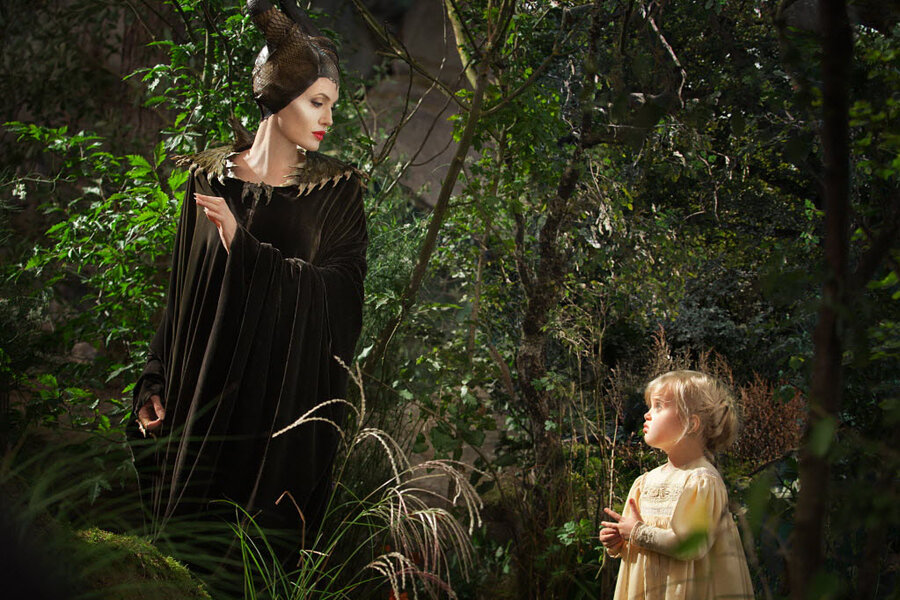From pixels to pixies: How 'Maleficent' animators brought their characters to life
Loading...
Thanks to visual effects artists, Angelina Jolie's statuesque portrayal of the malevolent and magnificent "Maleficent," which opened in theaters last Friday, commands moviegoers' attention but it is the whimsical and lifelike details used to create Princess Aurora's trio of good fairies that captures the audience's imagination.
Each fairy, or pixie, has a style inspired by nature. Knotgrass's red flowing flower petal dress is inspired by crimson daylilies, carnations and roses and her hat is made from individual leaves and flowers. Hundreds of blue and white hydrangea flowers create the bodice and sleeves of the "blue" fairy Flittle's dress and her skirt is composed of blue mint leaves. The green-yellow palette for Thistletwit's dress and headdress is fashioned from dandelion flowers and seed wisps.
"The most complex thing we were responsible for was the pixies," said Kelly Port, visual effects supervisor at Digital Domain in Los Angeles. "There were so many close-up shots with full dialog; we had to go closer than ever."
"Maleficent" is a mix of two film types, live action and animation, which created some unique challenges for the visual effects artists. Traditionally in animated films, the CG – computer-generated – characters often resemble the actor or actress that provides the voice of the character but the performer is never seen in the film. In "Maleficent," viewers see both CG fairies and the actresses portraying them on the screen.
"We needed the pixies to resemble the three actresses playing them and maintain the essence of the actresses," said Port. They did this by honing in on a crucial portion of each face, the "T" made up of the eyes, nose and mouth. To create the best digital 3-D models of each actress, Port turned to Paul Debevec, chief visual officer at the University of Southern California's Institute for Creative Technologies in Los Angeles. Debevec was part of the team that developed the Light Stage system.
"The system surrounds actors in a sphere of computer-controlled LED lights and cameras in order to scan high-resolution 3-D models of faces," said Debevec. "We had each of the actresses sit in the Light Stage and asked them to go through a whole range of facial expressions (neutral, happy, sad, surprised) and visemes, which are the shapes the mouth makes uttering different consonants and vowels."
While the actresses hold each desired facial expression for three seconds, seven cameras shoot 16 photographs of each pose. This helps the artists and scientists see how each actress's face reflects light from different angles.
"Our light stage processes record near-perfect digital models of the shape and appearance of actor’s faces, down to every skin pore, fine crease, and freckle, so that digital versions of an actor can look precisely like the person playing them," said Debevec.
This process allows animators to subtly modify an actor's appearance, and make them more pixie-like, he said. Another challenge for the artists was creating photo-realistic skin of each actress that would correspond to their fairy form. "By placing a photograph of the actress next to a CG version of the very same actress, and have them essentially indistinguishable, it provided a level of comfort and confidence prior to proceeding into the next design phase," said Port. "Once we couldn't tell one from the other, we knew we had achieved our technical goal."
The things that make a person look alive are the same things that animators have to recreate to make a CG character look realistic. "One of the new things that hasn't been done before is an improved blood flow technique to show extreme emotions such as a red splotchy face," said Port. "For example, if a character is angry and their face turns red, there is an animated six second delay and some of the blood flows away from the face, just like it would do in your body; it is very subtle but adds to the realism."
With each film there are new challenges and the artists build, improve and stretch the limits of technology to do new things. "'Maleficent' is real step forward in [creating] CG characters, not just because of how much on the screen is actually digital, but because of how faithfully what was originally real about the actors and their performances was successfully translated up onto the screen," said Debevec. "Close-ups of CG human-like characters are still difficult to create and thus relatively rare in films."
There is an example of a close-up shot that is completely computer generated towards the end of the film. "There is a scene where the pixies are in Aurora's bedroom and the fairies are fretting about what to do next and there is a close-up of Thistletwit sitting cross-legged by the door," said Port. The shot shows the astonishingly realistic details of Thistletwit's facial expression and the charming notes of her dandelion headpiece as if she was actually sitting in front of a digital camera.
Perhaps the greatest compliment to the visual effects artists for "Maleficient" is the fact that most moviegoers won't even notice that scene but will be completely immersed in the work that the artists have created.
Emilie Lorditch is an editor and writer for Inside Science TV; she tweets @EmilieLorditch.
Originally posted on Inside Science News Service.





